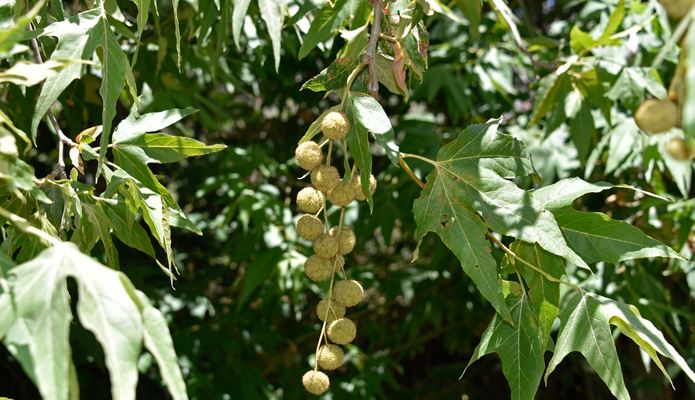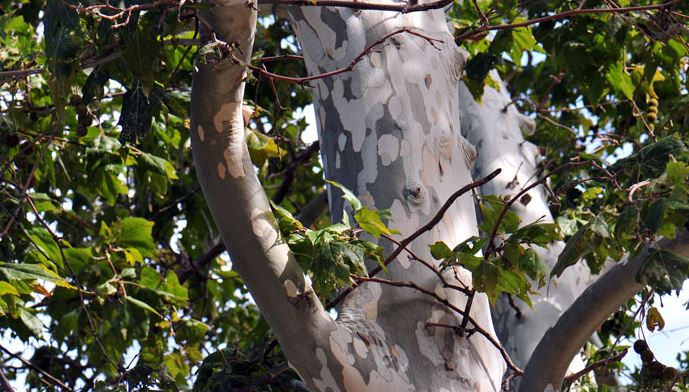
The Arizona Sycamore (Platanus wrightii), also known as the Arizona Plane Tree, is a stately deciduous tree native to the American Southwest and northern Mexico, cherished for its dramatic mottled bark, star-shaped leaves, and vital role in desert riparian ecosystems. This towering sycamore thrives along streams and canyons, offering shade, stabilizing soils, and supporting biodiversity in arid landscapes.
Its sculptural form and resilience make it a prized choice for native plant gardens and restoration projects. In this detailed guide, we explore the botanical classification, origin, identifying characteristics, habitat, distribution, USDA hardiness zones, uses, and fascinating facts about the Arizona Sycamore.
Botanical Classification, Origin and Native Area
The Arizona Sycamore, scientifically named Platanus wrightii, belongs to the Platanaceae family, a small family of broadleaf trees primarily within the genus Platanus. The species name wrightii honors American botanist Charles Wright, who collected specimens in the 19th century. As an angiosperm, it produces flowers and seeds, with a monoecious reproductive system featuring separate male and female flowers on the same tree.
Its taxonomic relatives include the California Sycamore (Platanus racemosa), Mexican Sycamore (Platanus mexicana), and American Sycamore (Platanus occidentalis), with P. wrightii distinguished by its deeply lobed, star-shaped leaves and clustered seed balls. Its classification is stable, with minimal hybridization in the wild, preserving its unique traits adapted to desert environments.
The Arizona Sycamore is native to the American Southwest and northern Mexico, evolving in the arid landscapes of the Sonoran and Chihuahuan Deserts. Its fossil record traces back to the Miocene, when Platanus species were widespread across North America. Indigenous peoples, such as the Apache and Tohono O’odham, utilized its wood for tools and its shade for communal spaces, integrating it into their cultural practices.
The tree’s preference for perennial and intermittent streams shaped its ecological role, anchoring desert riparian zones. Its historical significance is reflected in Arizona’s place names, like Sycamore Canyon, and its introduction to cultivation has expanded its presence in xeriscapes and urban landscapes, though native populations face threats from water diversion and drought.
Identifying Characteristics

The Arizona Sycamore is a large deciduous tree, typically growing 40–80 feet (12–24 meters) tall, with some specimens reaching 100 feet (30 meters) and trunk diameters up to 6–10 feet. Its canopy is broad and open, with twisting, angular branches creating a sculptural silhouette. The bark is a defining feature, peeling in patches to reveal a mottled pattern of creamy white, gray, and tan, especially striking in winter.
Leaves are large (6–9 inches wide), alternate, simple, and deeply lobed with 3–5 star-shaped, pointed lobes, bright green above and paler below, turning yellow to bronze in fall. The tree produces spherical seed balls (1–1.5 inches), typically in clusters of 2–4 on long stalks, dispersing fuzzy achenes. Its angular twigs and large, conical buds enhance its rugged aesthetic.
Habitat
The Arizona Sycamore thrives in desert riparian zones, including canyon bottoms, streambanks, and washes with perennial or intermittent water. It prefers moist, well-drained soils (pH 6.0–8.0), typically sandy, gravelly, or loamy, but tolerates rocky substrates. The tree is flood-tolerant, with deep roots adapted to seasonal inundation, and requires full sun for optimal growth.
It often grows in mixed stands with cottonwoods, willows, and mesquite, stabilizing soils and shading aquatic habitats in desert ecosystems. In cultivation, it adapts to urban landscapes, native gardens, and xeriscapes, provided moisture is available during establishment, though it may struggle in compacted or consistently dry soils without irrigation.
Distribution
The Arizona Sycamore is distributed across the American Southwest, including Arizona, New Mexico, and western Texas, with extensions into northern Mexico (Sonora, Chihuahua, and Coahuila). Its range centers on desert mountain ranges like the Santa Catalina, Huachuca, and Chiricahua Mountains, typically at elevations of 2,000–6,000 feet (600–1,800 meters).
Notable populations occur along Arizona’s Verde River, Sabino Canyon, and New Mexico’s Gila River. It has been planted in urban areas and native plant gardens in the Southwest and beyond, including California and Nevada, for shade and ornamental purposes. The tree is not invasive but can naturalize in moist, disturbed sites. Its distribution is limited by water availability, making it a key indicator of healthy riparian systems.
USDA Hardiness Zones
The Arizona Sycamore thrives in USDA Hardiness Zones 7–9, tolerating minimum temperatures from 0°F to 20°F (-18°C to -7°C). It is well-suited to warm, arid climates with hot summers and mild winters, though it can endure light frost and occasional cold snaps. In Zone 7, young trees may require protection from severe cold, while in Zones 8–9, they flourish with minimal care. Its drought tolerance, once established, and flood resilience make it ideal for desert landscapes and riparian restoration, though supplemental irrigation is needed in extremely arid conditions.
Uses
The Arizona Sycamore is a cornerstone of ecological, ornamental, and cultural applications. Ecologically, it stabilizes streambanks, prevents erosion, and provides critical habitat for wildlife, including nesting sites for birds (e.g., owls, woodpeckers) and shade for aquatic species like fish. Its canopy supports pollinators like bees and butterflies.
In landscaping, its mottled bark, star-shaped leaves, and sculptural form make it a stunning shade tree for parks, large yards, or native gardens, though its shedding bark and seed balls require maintenance. The wood, lightweight and coarse, is used for furniture, crates, and pulp, though less commonly than other sycamores. In urban settings, it mitigates stormwater, sequesters carbon, and cools environments, enhancing sustainable designs. Culturally, it symbolizes the Southwest’s desert heritage, often featured in conservation efforts to restore riparian habitats.
Fun Facts
The Arizona Sycamore is rich with captivating facts. Its deeply lobed, star-shaped leaves, unique among sycamores, shimmer in desert breezes, earning it the nickname “star tree” among local enthusiasts. Some specimens live over 200 years, with gnarled trunks becoming natural sculptures in Arizona’s canyons. Unlike American Sycamore, it is highly resistant to anthracnose, making it a low-maintenance choice in arid climates.
Its mottled bark, glowing white in sunlight, inspired Native American stories of “spirit trees.” The tree’s seed balls attract birds like finches, which feed on the fuzzy achenes, aiding seed dispersal. In Sycamore Canyon, Arizona, massive specimens form cathedral-like groves, drawing hikers and photographers. Finally, its ability to thrive in desert washes with minimal water showcases its remarkable adaptation to one of North America’s harshest environments.
Cultivation of Arizona Sycamore (Platanus wrightii)
Cultivating the Arizona Sycamore (Platanus wrightii), a resilient deciduous tree native to the American Southwest and northern Mexico, is a valuable endeavor for gardeners, landscapers, and conservationists aiming to enhance desert riparian zones, native plant gardens, or large landscapes with a sculptural, shade-providing tree. Known for its mottled bark, star-shaped leaves, and ecological importance, this tree thrives in arid climates but requires careful management to support its establishment, manage its size, and prevent pests.
- Climate Suitability: Arizona Sycamore thrives in USDA Hardiness Zones 7–9, tolerating minimum temperatures from 0°F to 20°F (-18°C to -7°C). It prefers warm, arid climates with hot summers and mild winters, similar to its desert origins. In Zone 7, protect young trees from severe frost to prevent branch or leaf damage.
- Site Selection: Choose a spacious location with full sun, receiving at least 6–8 hours of direct sunlight daily, to support its broad, open canopy and vigorous growth. Ensure the site accommodates its mature size (40–80 feet tall, 30–50 feet wide) and avoid planting near buildings, sidewalks, or utilities due to its extensive roots and shedding bark.
- Soil Requirements: Plant in well-drained, moist soil with a pH of 6.0–8.0, preferably sandy, gravelly, or loamy, mimicking its riparian canyon habitat. The tree tolerates rocky substrates and periodic flooding but thrives in fertile soils. Test soil drainage and amend with organic matter (e.g., compost) if needed to enhance fertility without compromising aeration.
- Planting Time: The optimal planting seasons are early spring or fall, allowing roots to establish before summer heat or winter cold. Dig a hole twice as wide and as deep as the root ball, positioning the root collar at or slightly above ground level. Backfill with native soil, tamp gently, and water deeply to settle the roots and eliminate air pockets.
- Watering Needs: Water young trees deeply (1–2 times weekly) for the first 1–2 years to establish a strong root system, keeping soil consistently moist but not waterlogged. Once established, the sycamore is flood-tolerant and highly drought-tolerant, requiring supplemental watering only during prolonged dry spells in arid conditions.
- Mulching: Apply a 2–4 inch layer of organic mulch (e.g., wood chips, bark) or inorganic mulch (e.g., gravel) around the base, extending to the drip line but keeping it 2–4 inches from the trunk to prevent rot. Mulch conserves moisture, regulates soil temperature, and suppresses weeds, supporting young trees in xeriscapes or native gardens. Replenish mulch annually.
- Fertilization: Fertilize young trees in early spring with a balanced, slow-release fertilizer (e.g., 10-10-10) to promote healthy growth, applying at half the recommended rate to avoid excessive foliage at the expense of root development. Mature trees rarely need fertilization in fertile riparian soils, as they are adapted to nutrient-rich environments.
- Pruning: Prune in late winter or early spring to remove dead, damaged, or crossing branches and to shape the canopy, using clean, sharp tools to prevent disease spread. Young trees may need structural pruning to develop a strong framework. Minimize cuts to reduce susceptibility to fungal diseases, and avoid heavy pruning to maintain its sculptural form.
- Pest and Disease Management: Monitor for pests like sycamore scale, lace bugs, or borers, treating infestations with insecticidal soap or neem oil. The tree is highly resistant to anthracnose, a common sycamore disease, but may develop powdery mildew in humid conditions; improve air circulation and remove debris to manage diseases. Ensure good drainage to prevent root issues.
- Spacing: Space trees 30–50 feet apart to accommodate their mature canopy spread, ensuring adequate sunlight and air circulation to reduce disease risk. For riparian restoration or group plantings, plant 20–30 feet apart to mimic natural stands. Consider their height (up to 80 feet) when planning near structures or power lines.
- Wind Protection: Young sycamores, with shallow roots, are susceptible to windthrow in exposed desert areas. Stake newly planted trees for the first 1–2 years using flexible ties to allow slight trunk movement, which strengthens roots. Remove stakes once established to promote independent growth and prevent girdling.
- Winter Care: In Zone 7, protect young trees from winter damage by wrapping trunks with burlap to prevent frost cracks and mulching heavily around the base to insulate roots. Water adequately before freeze-up to prevent dehydration, as deciduous trees can lose moisture in winter. Mature trees are cold-hardy and require minimal winter care in arid climates.
- Long-Term Growth: Arizona Sycamores grow moderately fast (1–2 feet per year), reaching 40–80 feet at maturity, with lifespans of 150–200 years in optimal conditions. Their mottled bark, star-shaped leaves, and ecological benefits make them ideal for shade, erosion control, or wildlife habitat in desert landscapes. Regular monitoring for pests and structural integrity ensures longevity.